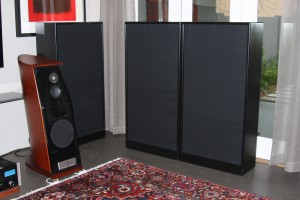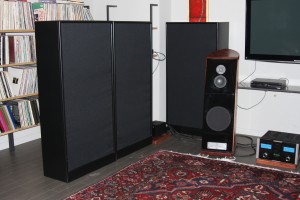We work both in the professional and consumer markets. They are the same in some respects but radically different in others. Both seek “good” sound quality, but go about it in different ways. The professionals use their room and the sound in it to make a living through the recording process. The consumer is all about playback and taking the recorded sound and actively listening to it in their rooms and so tuning a listening room is going to be slightly different for the two audiences as the rooms they use to accomplish both their purposes are radically different.
Tuning A Listening Room
Different Functions
Professionals want to hear everything that is going on in the mix. Their rooms are set up and treated to avoid most of the issues that small rooms have on sound quality. Most professionals want less room sound and more of just the instrument or vocal. If the room is a vocal room, it is set up to minimize reflections at the microphone position, so there is less room sound. Consumers rooms are usually rooms that have multiple functions attached to them. They are usually living rooms where many individuals socialize and listening to music is a secondary function.
Different Room Surfaces
With a living room, we have numerous types of room surfaces that must be dealt with. We have drapes, fireplaces, and the dreaded windows which can run across a whole wall. Recently, we were asked to tune a room for a client that had one whole wall as a glass window, a large video screen on the front wall, and a alcove full of albums for the front wall. With our right channel speaker next to a large window of glass and our left channel speaker positioned next to an alcove full of albums, one can immediately see the acoustical issues that must be dealt with. Don’t forget about the large screen glass video display unit on the front wall.
Low Frequency Management
When tuning any room, one should start with managing the low frequency energy first. Without proper low frequency management, there is nothing for the middle and high frequencies to sit upon without getting smothered or blurred in an acoustical “mud”. Most listening rooms are not optimized in size to reduce the resonances created by low frequency issues, so one must use large amounts of low frequency absorption to assist with resonance control. with our room tuning project consisting of a 15′ width, low frequency resonances must be addressed.
Portable Acoustic Technology
In this client’s room, we needed to manage everything. The room was 15′ wide with a full length glass window as one wall. The left channel had to fire its reflected energy into a alcove that was full of albums. At least the albums provided some mass to work with compared to the full length window on the right channel side. Our solution was to make a mobile “wall” that could be moved into place when listening and then moved away for living. Living and listening are two different room functions.
Dual Acoustic Purpose
Since our first goal with our 15′ wide room is resonance control with frequencies from 30 Hz. – 80 Hz., we must have a low frequency absorber that is capable of handling this energy. We also need to handle the reflections from our speakers off of the glass. To accomplish both of these objectives, we built larger sizes of our ACDA-10 and ACDA-12 series diaphragmatic absorbers that would cover a larger surface area. They were 30″ wide and 60″ tall on casters since they had to be mobile. They also weighed in at 250 pounds each. You must have mass when dealing with low frequency energy. There is simply no substitute for mass.
Middle And High Frequencies
To deal with the middle and high frequency issues within the room, we attached our 2″ foam to the face of each unit, directly behind the fabric. The foam technology begins its absorption at 125 cycles and goes through 7,500. The ACDA-10 unit starts its absorption process at 30 Hz. and goes through 200 Hz. With the addition of our foam technology, we now have a unit that can absorb energy beginning at 30 cycles and advancing through 7,500 cycles.
Front Wall
Our next step is to work on the front wall where the center image of our sound stage resides. It resides there because we have used the proper amount of absorption for the side ‘walls” to lower the time of the primary reflection from the side walls. We must lower the time signature of both the side wall reflections so they arrive at the listening position after the wanted, direct, sound from our speakers.
Absorption Technology
Since we have a video screen that is mounted on the front wall and the glass surface of it must be covered, we can install a portable panel that can be hung over the video display screen when playing music and then removed for video viewing. This panel will contain the same sound absorption technology as the side walls. It must be light in weight so as to not add too much additional weight to the video screen mount system.
Listening / Living Rooms
Listening rooms must serve multiple functions in most consumer environments. Unfortunately, this does not allow for the proper room acoustic treatment to be installed in the correct locations to compliment our stereo presentation. Any acoustical technologies used must be mobile and removable if you are tuning a listening room correctly. All frequencies must be addressed from low frequency room resonances to middle and high frequency reflections from side walls. Room treatment technologies can be developed that can be positioned in place when playing music and removed or repositioned when other room functions are desired.







